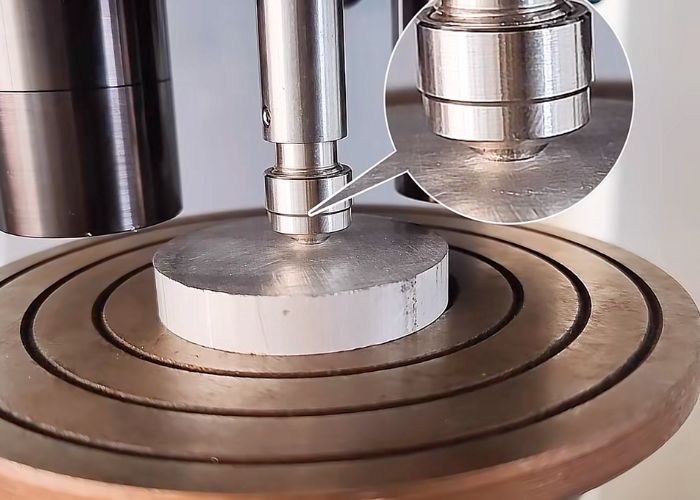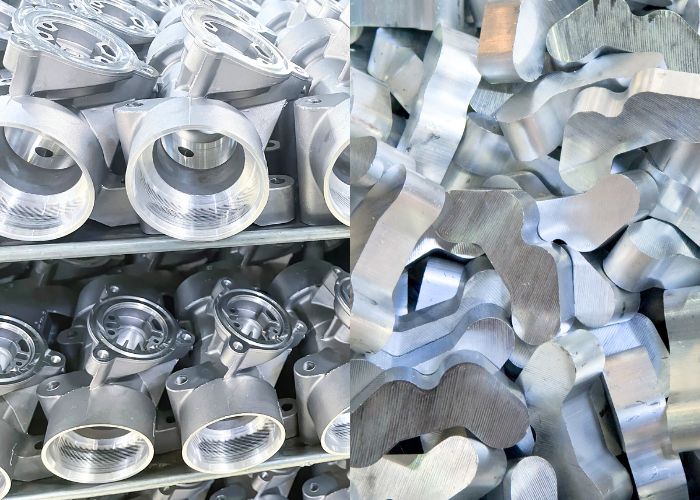Aluminum alloy 6061 and 7075 are widely used in aerospace, automotive, shipbuilding and construction industries due to their excellent comprehensive performance. Hardness is an important indicator of the metal’s ability to resist compression, tension and impact. As a professional focusing on CNC processing, I am well aware of the impact of material selection on product quality. I will help you deeply understand the hardness characteristics of these two aluminum alloys and make the best decision based on application requirements.
Was Is 6061 Aluminum Alloy
6061 aluminum alloy is widely used in the automotive, construction and shipbuilding industries due to its good weldability, machinability and strong corrosion resistance. In many projects I am responsible for, 6061 aluminum alloy can meet the high strength and durability requirements, and it is also one of the materials I use most in CNC machining.
Chemical Composition Analysis
The chemical composition of 6061 aluminum alloy has a decisive influence on its performance. It is mainly composed of aluminum (Al), magnesium (Mg) and silicon (Si), with the magnesium content ranging from 1.0% to 1.5% and the silicon content ranging from 0.4% to 0.8%. This makes 6061 aluminum alloy not only have high corrosion resistance, but also maintain good processability while ensuring strength.
Compared with 7075 aluminum alloy, 6061 has a lower magnesium content, so its strength is not as good as 7075, but it has obvious advantages in weldability and machinability.
I once provided 6061 aluminum alloy parts to a ship manufacturer. These parts need to withstand long-term corrosion from seawater, but the strength requirements are not as high as 7075. 6061 aluminum alloy performs very well in such applications, maintaining sufficient strength while reducing processing difficulty.
Rockwell Hardness Ran
The Rockwell hardness of 6061 aluminum alloy is generally between 60 and 70 HRB. Although this hardness range is not very high, it is sufficient for most conventional applications.
In a construction project I participated in, the client required the use of 6061 aluminum alloy to manufacture building structural components. The requirements were both strong and able to withstand a certain impact force. The hardness of 6061 fully met this requirement. At the same time, its lower hardness also made the processing process simpler, which was conducive to cost control.
Was Is 7075 Aluminum Alloy
7075 aluminum alloy is famous for its high strength and hardness. It is a material I often use in some projects with particularly high requirements. 7075 aluminum alloy is widely used in high-strength demanding scenes such as aerospace and military fields. Compared with 6061 aluminum alloy, 7075 aluminum alloy has much higher hardness and strength, but its performance in weldability and machinability is relatively poor.

Chemical Composition Analysis
The chemical composition of 7075 aluminum alloy is different from 6061. It is mainly composed of aluminum (Al), zinc (Zn), copper (Cu) and magnesium (Mg). Among them, the content of zinc is usually between 5.1% and 6.1%, the content of copper is 1.2% to 2.0%, and the content of magnesium is 2.1% to 2.9%. These elements make 7075 aluminum alloy excellent in strength and hardness, but also sacrifice some machinability.
By analyzing the chemical composition of 7075 aluminum alloy, we can see that its high strength and hardness come from the alloying of zinc and copper.
I remember that I once provided 7075 aluminum alloy to an aviation parts manufacturer. These parts needed to withstand extremely high stress and load, and 7075 aluminum alloy just met this requirement, ensuring the safety and durability of the product.
Rockwell Hardness Ran
Die Rockwell hardness of 7075 aluminum alloy is usually between 70 and 78 HRB, which is significantly higher than that of 6061 aluminum alloy. This makes 7075 aluminum alloy have an advantage in high-strength applications.
In an aviation project I am in charge of, 7075 aluminum alloy is used to manufacture the wing brackets of aircraft. Because these components must withstand enormous flight pressure and external forces, the high hardness and high strength of 7075 aluminum alloy can ensure its performance in harsh environments.
6061 And 7075 Rockwell Hardness Comparison
We compare 6061 and 7075 aluminum alloys. 7075 aluminum alloy is suitable for high-load, high-strength applications due to its higher hardness and strength, while 6061 aluminum alloy is more used in conventional industrial applications that need to balance performance and cost.
To help you better understand the advantages and disadvantages of these two aluminum alloys, I will analyze them in detail from the aspects of hardness range, strength and toughness, and the effect of heat treatment on hardness :
| Compare Projects | 6061 Aluminum Alloy | 7075 Aluminum Alloy |
| Rockwell Hardness Range (HRB) | 60 – 70 HRB | 70 – 78 HRB |
| Tensile Strength(MPa) | 310 MPa | 570 MPa |
| Hardness After Heat Treatment (HRB) | 65 HRB (T6 heat treatment) | 78 HRB (T6 heat treatment) |
| Application Areas | General industrial applications, power equipment, automotive parts | High strength, high load applications, aerospace, military |
| Toughness | Higher toughness, suitable for impact resistance and fatigue resistance requirements | High strength, suitable for bearing large tensile forces and high stresses |
| Typical Application Cases | For use in power company components and general industrial applications | Used in high-load applications such as automotive structural parts to ensure long-term durability |
| Hardness Change Analysis | After T6 treatment, the hardness is increased to 65 HRB | After T6 treatment, the hardness is increased to 78 HRB |
| Hardness After Heat Treatment (HRB) | 65 HRB | 78 HRB |
| Effect Of Heat Treatment | Heat treatment increases the hardness of the alloy, making it suitable for common industrial needs | Heat treatment significantly increases hardness, making it suitable for high-strength and high-load applications |
Faktoren Affecting Ter Hardness Of 6061 And 7075
Hardness is not only determined by alloy elements, but also the heat treatment process and manufacturing process are important factors that determine hardness. In my many years of practice, I often adjust the alloy element ratio or choose different heat treatment processes according to different customer needs to achieve the best hardness requirements.

Alloy Element Content
The content of alloying elements is a key factor affecting the hardness of aluminum alloys. The high zinc content of 7075 aluminum alloy makes it harder than 6061 aluminum alloy. The 6061 aluminum alloy has higher magnesium content
Content to balance its strength and processability. Different application requirements determine our choice of different alloy elements in aluminum alloys. For example, in the automotive industry, 6061 aluminum alloy is widely used because of its good processability and moderate hardness.
Heat Treatment Prozess
The heat treatment process is the core that determines the hardness of aluminum alloys. By controlling the heating temperature, holding time and cooling rate, the microstructure of the alloy can be adjusted to achieve the desired hardness. For example, the T6 heat treatment process of 7075 aluminum alloy significantly increases its hardness. In my projects for aerospace companies, we pay special attention to the heat treatment process of 7075 aluminum alloy to ensure that the parts can withstand extreme working conditions.
Manufacturing Prozess Aund Finished Produkt Status
The way the aluminum alloy is processed and the final state of the finished product can also affect the hardness. For example, aluminum alloys that are hot-pressed or cast generally have lower hardness, while aluminum alloys that are manufactured through cold working or extrusion processes have higher hardness. I have provided finished products of 6061 aluminum alloy to customers, and the way these parts are processed directly affects their hardness, ensuring that they can achieve optimal performance in specific applications.
Wie To Choose Ter Right Aluminum Alloy
When choosing a suitable aluminum alloy, hardness is important, but there are many other factors that need to be considered. In my experience, in addition to hardness, application requirements, cost, processing performance, and quality requirements of the final product also need to be considered.
Hardness Requirements Of Application Needs
When choosing an aluminum alloy, you first need to clarify the hardness requirements. If the product needs to withstand high loads and high impacts, you should choose 7075 aluminum alloy. If the product requires medium strength and good processing performance, 6061 aluminum alloy is a more suitable choice.
For example, 7075 aluminum alloy performs well in applications with high loads and high impacts, so it is suitable for high-demand fields such as aerospace and military. For example, I once customized 7075 aluminum alloy wing brackets for an airline company. These brackets need to withstand extremely high loads, so the hardness and strength of 7075 aluminum alloy become its key features.
In contrast, 6061 aluminum alloy is suitable for applications that require moderate strength and good processing performance. For example, I once manufactured a large number of 6061 aluminum alloy power equipment parts for a company. Although these parts do not need to withstand great tension, they must be able to withstand frequent impact and vibration. 6061 aluminum alloy provides very good toughness and processing properties.
Die Trade-Off Bzwischen Cost Aund Processing Performance
6061 aluminum alloy has a greater cost advantage and better machinability, making it suitable for mass production. However, the high hardness and strength of 7075 aluminum alloy make it more demanding in processing and the production cost is relatively high. Therefore, when choosing aluminum alloy, we need to make a trade-off based on budget and production needs.
In a project to provide car body parts for a large automobile manufacturer, cost and processing performance were key factors in selecting aluminum alloys. 6061 aluminum alloy was selected due to its lower cost and good processing performance, suitable for large-scale production. 7075 aluminum alloy is more suitable for high-strength applications, such as key components in the aerospace field. Although it is more expensive, its strength and hardness are sufficient to meet the stringent requirements.
Hardness Application Scenarios Of 6061 And 7075
6061 and 7075 aluminum alloys are widely used in a variety of key fields due to their different hardness and strength characteristics. Whether in aircraft wings, car bodies, or in construction, sports equipment, ships and marine engineering, these two aluminum alloys play an important role. Choose the right aluminum alloy according to your needs to ensure the excellent performance and long-term reliability of the product in the respective application scenarios.

Luft- und Raumfahrt Applikationen
In the aerospace field, 7075 aluminum alloy is an ideal choice due to its high strength and hardness. The strength of 7075 aluminum alloy makes it outstanding in parts that need to withstand high loads and high stresses, especially in the manufacture of aircraft structures and key components, such as aircraft wings and aircraft frames. The high strength and hardness of 7075 aluminum alloy enables it to withstand the huge stress during flight, ensuring the long-term stability and reliability of the material. At the same time, its excellent corrosion resistance also makes it suitable for use in extreme environments.
Anmeldung In Ter Automotive Industrie
6061 aluminum alloy is widely used in the automotive industry due to its good processing performance and medium strength, especially for the manufacture of body structures, wheels, brackets, chassis and other automotive parts. Although 6061 aluminum alloy is slightly lower in strength than 7075, its good toughness and corrosion resistance make it very suitable in automotive parts, especially in applications that need to withstand certain shocks and vibrations. In addition, the lower cost and better processability of 6061 aluminum alloy make it an ideal choice for large-scale production.
Anwendungen In Architecture And Structural Engineering
In construction and structural engineering, 6061 aluminum alloy is often used to manufacture large-span structural parts, support frames, etc. Although these structural parts do not need to bear extremely high loads, they must have good corrosion resistance and toughness to cope with complex environmental conditions. The corrosion resistance and processing properties of 6061 aluminum alloy make it perform well in these applications, and due to its lower cost, it has also become a popular choice in these industries.
Sports EAusrüstung Aund Gear
7075 aluminum alloy is also widely used in high-performance sports equipment, such as bicycle frames, golf clubs, skis and other sports equipment. Due to the high strength of 7075 aluminum alloy, it can maintain structural stability under high impact conditions, ensuring the safety and long-term durability of the equipment. In addition, the lightweight characteristics of 7075 aluminum alloy make it the preferred material for high-end sports equipment, especially suitable for applications that require high strength and light weight.
Shipbuilding Aund Marine Engineering
Due to its excellent corrosion resistance and high strength, 7075 aluminum alloy is widely used in shipbuilding and marine engineering. The high strength of 7075 aluminum alloy can withstand the huge load in the marine environment, while its corrosion resistance ensures that parts exposed to seawater for a long time are not easy to rust, extending the service life. Common applications include hull structures, porthole frames and key support structures of offshore platforms.
FAQs
Wie Do We Change Ter Hardness Of Aluminum Alloys?
If we want to change the hardness of aluminum alloy, we usually need to do it through heat treatment, the most common of which is T6 treatment. This process involves heating the aluminum alloy to a specific temperature, then rapidly cooling it, and performing an aging treatment. Heat treatment can increase the hardness and strength of aluminum alloys, and the cooling rate and alloy composition also have an impact on the hardness. Therefore, when choosing a heat treatment method, we need to adjust it according to the material composition and target hardness.
Was Azu Ter Concepts Of Rockwell Hardness And Vickers Hardness?
The Rockwell hardness test determines the hardness by applying different loads and measuring the depth of the indentation on the metal surface. It is fast and suitable for most metals. The Vickers hardness test calculates the hardness by measuring the diagonal length of the impression and is often used for hardness testing of thin materials or coatings.
Was Metal Makes Ter Alloy Harder?
The elements zinc, copper and magnesium in aluminum alloys can significantly increase the hardness. 7075 aluminum alloy contains higher zinc, and its hardness and strength are generally higher than 6061 aluminum alloy. Copper and magnesium also optimize the alloy’s strength and toughness.
Warum Azu Two Loads Used In Rockwell Hardness Testing?
Rockwell hardness testing uses initial load and main load to avoid excessive damage to the surface of our samples and ensure more accurate test results. The initial load brings the indenter into contact with the surface, and the main load measures the hardness of the metal.
Was Is Ter Difference In Hardness Between 6061 And 7075 Aluminum Alloys?
The hardness of 7075 aluminum alloy is higher than that of 6061. The Rockwell hardness is usually between 70-78 HRB, while 6061 is at 60-70 HRB. 7075 aluminum alloy has higher strength and is suitable for high strength and high load applications.
Was Is Ter Effect Of Heat Treatment On Ter Hardness Of Aluminum Alloys?
Heat treatment significantly affects the hardness of aluminum alloys. By adjusting the temperature and cooling rate, the microstructure can be changed and the hardness increased. After T6 treatment, the hardness of 7075 aluminum alloy is significantly improved, which makes it widely used in high-strength fields.
Conschluss
6061 and 7075 aluminum alloys each have their own advantages and disadvantages. When choosing a suitable aluminum alloy , we need to consider hardness, strength, toughness and application requirements. 7075 is widely used in high-demand areas due to its high hardness and strength, while 6061 is suitable for many general industrial applications due to its better processing performance and medium hardness. Understanding these hardness differences and influencing factors can help us make the best choice to meet specific design requirements.
